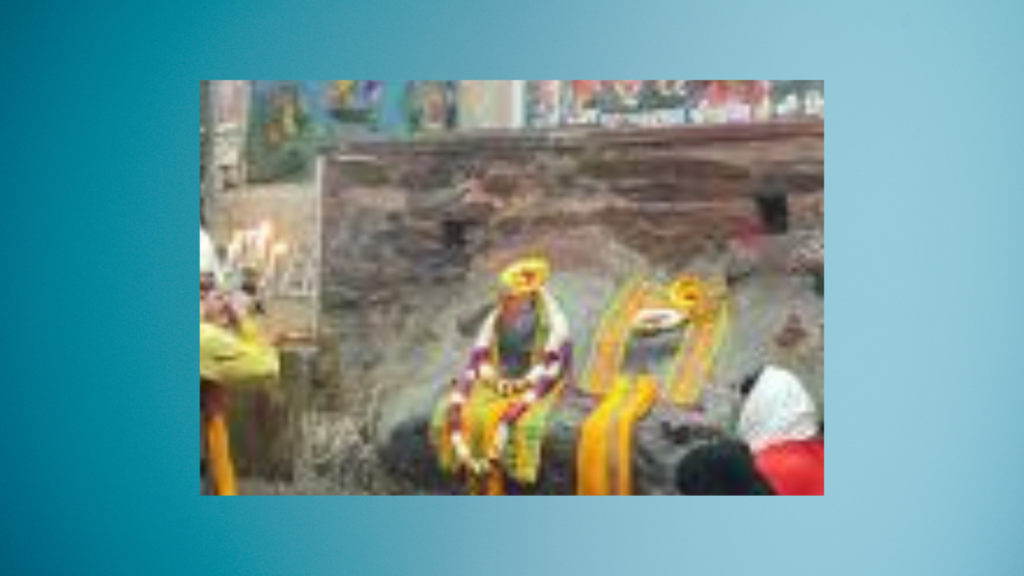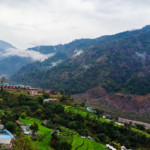Imagine standing at the foot of the sacred Govardhan Hill, where the air hums with devotion, and the ancient stones whisper tales of Lord Krishna’s divine pastimes. Welcome to the Jatipura Temple, a spiritual beacon in the heart of Uttar Pradesh’s Jatipura village, revered as the epicenter of Govardhan Parikrama. Known as Shri Giriraj Ji Mukharvind Temple, this sacred site draws millions of Vaishnav devotees worldwide, offering a profound connection to Lord Krishna and Shrinathji. In this comprehensive guide, we’ll unravel the history, spiritual significance, and practical tips for visiting Jatipura Temple, blending sensational storytelling with educational insights. This blog post is your ultimate resource for planning a transformative pilgrimage in 2025. Let’s embark on a divine journey!
What Is Jatipura Temple? A Sacred Haven
Jatipura Temple, officially called Shri Giriraj Ji Mukharvind Temple, is a revered Vaishnav pilgrimage site located in Jatipura village, just 4 km from Govardhan and 28 km from Mathura, Uttar Pradesh. Nestled at the base of Govardhan Hill, this temple is celebrated as the “lotus face” of Lord Giriraj, a manifestation of Lord Krishna or Shrinathji. The temple’s central deity is a rock formation believed to embody Govardhan Hill, worshipped with milk, flowers, and sweets like potato jalebi. It serves as the starting point for the 21-km Saat Kosi Parikrama, a sacred circumambulation of Govardhan Hill, making it a cornerstone of Vaishnav devotion.
The temple’s significance stems from its association with Lord Krishna’s Govardhan Lila, where he lifted Govardhan Hill to protect the Brijvasis from Lord Indra’s wrath. Devotees believe this is where Krishna rests nightly, and the rock is adorned to resemble Shrinathji during Shringar Darshan. With its rich history, vibrant rituals, and proximity to other holy sites like Radha Kund and Mansi Ganga, Jatipura Temple is a must-visit for spiritual seekers, history enthusiasts, and cultural explorers.
Why Visit Jatipura Temple in 2025?
In 2025, Jatipura Temple is poised to captivate over a million devotees, drawn by its spiritual aura and the allure of Govardhan Parikrama. The temple’s serene setting, coupled with its role in festivals like Govardhan Puja, makes it a bucket-list destination. Posts on X highlight recent pilgrimages, with devotees praising the temple’s divine energy during Shringar Aarti. Its accessibility from Mathura, Vrindavan, and Delhi, combined with affordable accommodations like Shri Giriraj Dham Bhawan, ensures a hassle-free visit. Whether you’re seeking spiritual awakening, cultural immersion, or a serene escape, Jatipura Temple offers an experience that resonates deeply, especially during the pleasant October-to-March season.
The Historical and Spiritual Significance of Jatipura Temple
Jatipura Temple’s history is intertwined with the sacred lore of Govardhan Hill and Vaishnav traditions. Originally known as Gopalpur, the village was named for Lord Krishna’s role as Gopal, the cowherd. Over time, it became Jatipura, possibly after King Surajmal gifted the area to Jatisingh Jaat or in honor of Madhavendra Puri, a revered saint called “Yati” (pronounced “Jati” in Vraj dialect). Madhavendra Puri, a 15th-century Vaishnav saint, is credited with discovering Lord Shrinathji on Govardhan Hill, performing the first abhishek and Annakut ceremonies at Jatipura.
The temple itself is believed to mark the spot where Lord Krishna enacted Govardhan Lila, lifting the hill to shield Brijvasis from torrential rains. The Mukharvind rock, seen as Krishna’s divine face, is a focal point of worship, especially for followers of the Pushtimarg sect. Historical records note that a Kshatriya named Purnamall built a grand Shrinathji temple here at a cost of four lakh rupees, as ordained by Shri Mahaprabhuji. The temple’s cave-like Shaiyya Mandir, rumored to connect to Mewar, adds an air of mystique. Jatipura’s spiritual legacy is further enriched by its association with Chaitanya Mahaprabhu, who performed parikrama without climbing the hill, revering it as Krishna himself.
Key Features of Jatipura Temple
Jatipura Temple is more than a place of worship; it’s a spiritual ecosystem. Here are its standout features:
Mukharvind Rock
The temple’s heart is the Mukharvind rock, a natural formation at Govardhan Hill’s base, worshipped as Lord Giriraj’s face. Devotees offer milk, flowers, and potato jalebi, believing it embodies Krishna’s divine presence. The rock is elaborately decorated during Shringar Darshan, resembling Shrinathji with intricate adornments.
Shringar Sthali and Rituals
Known as Shringar Sthali, the temple hosts daily rituals like Shringar Darshan, Shringar Aarti, and Shayan Aarti, where the rock is adorned with jewelry and fabrics. These ceremonies, especially vibrant during Govardhan Puja, draw thousands who fall in love with Krishna’s divine form.
Govardhan Parikrama Starting Point
Jatipura Temple marks the start of the 21-km Saat Kosi Parikrama, a sacred walk around Govardhan Hill. The route covers sites like Mansi Ganga Kund, Radha Kund, and Govind Kund, with some devotees performing Doodh Dhaar Parikrama, pouring milk continuously.
Nearby Sacred Sites
The temple’s proximity to other holy sites enhances its appeal. The Shrinathji Temple (650 meters away), Rudrakund, Giriraj Baug, and Sringa Sthali, where devotees pour milk over Govardhan Shila, are all within walking distance.
How to Reach Jatipura Temple
Jatipura Temple is well-connected, making it accessible for pilgrims from across India and beyond. Here’s how to get there:
By Train
Mathura Junction, 23 km away, is the nearest railway station, with trains from Delhi (2.5 hours), Agra (1 hour), and major cities. From Mathura, hire a taxi (INR 500-700) or take an auto-rickshaw (INR 200-300) to Jatipura, a 40-50 minute ride.
By Road
Jatipura is 150 km from Delhi (3 hours via NH44), 80 km from Agra (1.5 hours), and 25 km from Mathura (40 minutes). Direct buses run from Delhi and Agra to Mathura, followed by local taxis or autos to Jatipura. The scenic route through Braj offers views of rural Uttar Pradesh. Private cabs from Mathura or Vrindavan (30 km) cost INR 800-1,200.
By Air
Agra’s Kheria Airport (60 km, 1.5 hours) is the closest, with limited domestic flights. For more options, fly to Delhi’s Indira Gandhi International Airport (180 km, 3.5 hours). From either airport, book a taxi or use public transport to Mathura, then proceed to Jatipura.
Local Transport
In Jatipura, auto-rickshaws and e-rickshaws are ideal for short distances, especially to parikrama sites. Bicycles or walking are popular for the parikrama itself, though e-autos are available for those
Best Time to Visit Jatipura Temple
The ideal time to visit Jatipura Temple is October to March, when temperatures range from 15-25°C, offering pleasant weather for parikrama and outdoor exploration. Key festivals like Govardhan Puja (a day after Diwali) and Guru Purnima see thousands of devotees, with Annakut offerings and vibrant celebrations. Avoid summer (April-June) due to scorching heat (35-40°C) and monsoon (July-September) due to muddy trails. Winter mornings are perfect for Shringar Darshan and parikrama, with clear skies and cool breezes.
Festivals and Rituals at Jatipura Temple
Jatipura Temple comes alive during festivals, offering a glimpse into Vaishnav devotion:
Govardhan Puja
Celebrated a day after Diwali, this festival commemorates Krishna’s lifting of Govardhan Hill. Devotees offer Annakut, a mountain of food, and perform parikrama, with the temple adorned with flowers and lights.
Guru Purnima
Held in July/August, this festival honors spiritual gurus like Madhavendra Puri. Devotees attend discourses and perform parikrama, with special aartis at the temple.
Daily Rituals
Shringar Darshan: Morning and evening adornment of the Mukharvind rock, resembling Shrinathji.
Shringar Aarti: Evening ceremony with lamps and chants, creating a divine ambiance.
Shayan Aarti: Nighttime ritual marking Krishna’s rest, with soothing bhajans.
Nearby Attractions to Explore
Jatipura’s location on Govardhan Parikrama Marg makes it a hub for spiritual exploration. Here are must-visit sites:
Shrinathji Temple: 650 meters away, this temple houses a deity discovered by Madhavendra Puri.
Rudrakund: A sacred pond near Giriraj Baug, linked to the Gopis’ tears during Krishna’s Rasa Leela.
Mansi Ganga Kund: A holy tank 3 km away, part of the parikrama route.
Radha Kund: 8 km from Jatipura, a sacred bathing site for devotees.
Vrindavan Prem Mandir: 26 km away, a stunning temple with light shows and gardens.
Mathura Krishna Janmabhoomi: 25 km away, the birthplace of Lord Krishna.
Practical Tips for Visiting Jatipura Temple
To ensure a seamless pilgrimage, follow these tips:
Dress Modestly: Wear traditional attire (kurta-pajama or saree) to respect temple customs.
Carry Essentials: Bring water, sunscreen, and a hat for parikrama, especially in winter.
Book Accommodations Early: Reserve dharamshalas like Shri Giriraj Dham Bhawan or Balkrishna Bhawan (INR 500-1,500/night) during festival seasons.
Hire a Guide: Local pandits like Bhanu Kaushik Ji offer Vedic rituals and historical insights (INR 500-1,000).
Respect Parikrama Etiquette: Walk barefoot or in socks, and avoid climbing Govardhan Hill, as it’s considered Krishna himself.
Try Local Food: Savor potato jalebi and peda at stalls near the temple, offered to Girirajji.
Stay Safe: Avoid crowded areas during festivals and keep valuables secure.
Festival Calendar for Jatipura Temple 2025
Festival | Date | Highlights |
|---|---|---|
Govardhan Puja | November (TBD) | Annakut offerings, parikrama, temple decorations |
Guru Purnima | July (TBD) | Spiritual discourses, special aartis |
Diwali | October/November | Milk offerings, temple illuminations |
Holi | March | Colorful celebrations, bhajans |
Note: Exact dates vary; check Andaman Tourism or local calendars closer to 2025.
FAQs About Jatipura Temple
What is Jatipura Temple famous for?
Jatipura Temple, or Shri Giriraj Ji Mukharvind Temple, is renowned for its Mukharvind rock, believed to be Lord Krishna’s face, and as the starting point for Govardhan Parikrama.
How long is the Govardhan Parikrama from Jatipura Temple?
The Saat Kosi Parikrama is 21 km, taking 5-7 hours on foot. Some use e-autos for a quicker journey.
What are the best rituals to attend at Jatipura Temple?
Shringar Darshan, Shringar Aarti, and Shayan Aarti are must-see, offering divine views of the adorned Mukharvind rock.
How can I book accommodations near Jatipura Temple?
Book dharamshalas like Shri Giriraj Dham Bhawan or Balkrishna Bhawan via YatraDham.org, starting at INR 500/night.
Is Jatipura Temple open year-round?
Yes, the temple is open daily from morning to evening, with peak crowds during festivals like Govardhan Puja.
Conclusion: Embrace the Divine at Jatipura Temple
Jatipura Temple is more than a pilgrimage site—it’s a portal to Lord Krishna’s divine legacy, where devotion, history, and nature intertwine. From the sacred Mukharvind rock to the transformative Govardhan Parikrama, this Vaishnav gem offers a spiritual journey like no other. Plan your 2025 visit with our guide, immerse yourself in rituals like Shringar Aarti, and explore nearby sites like Radha Kund. Whether you’re a devotee or a curious traveler, Jatipura Temple promises memories that echo with divinity.



